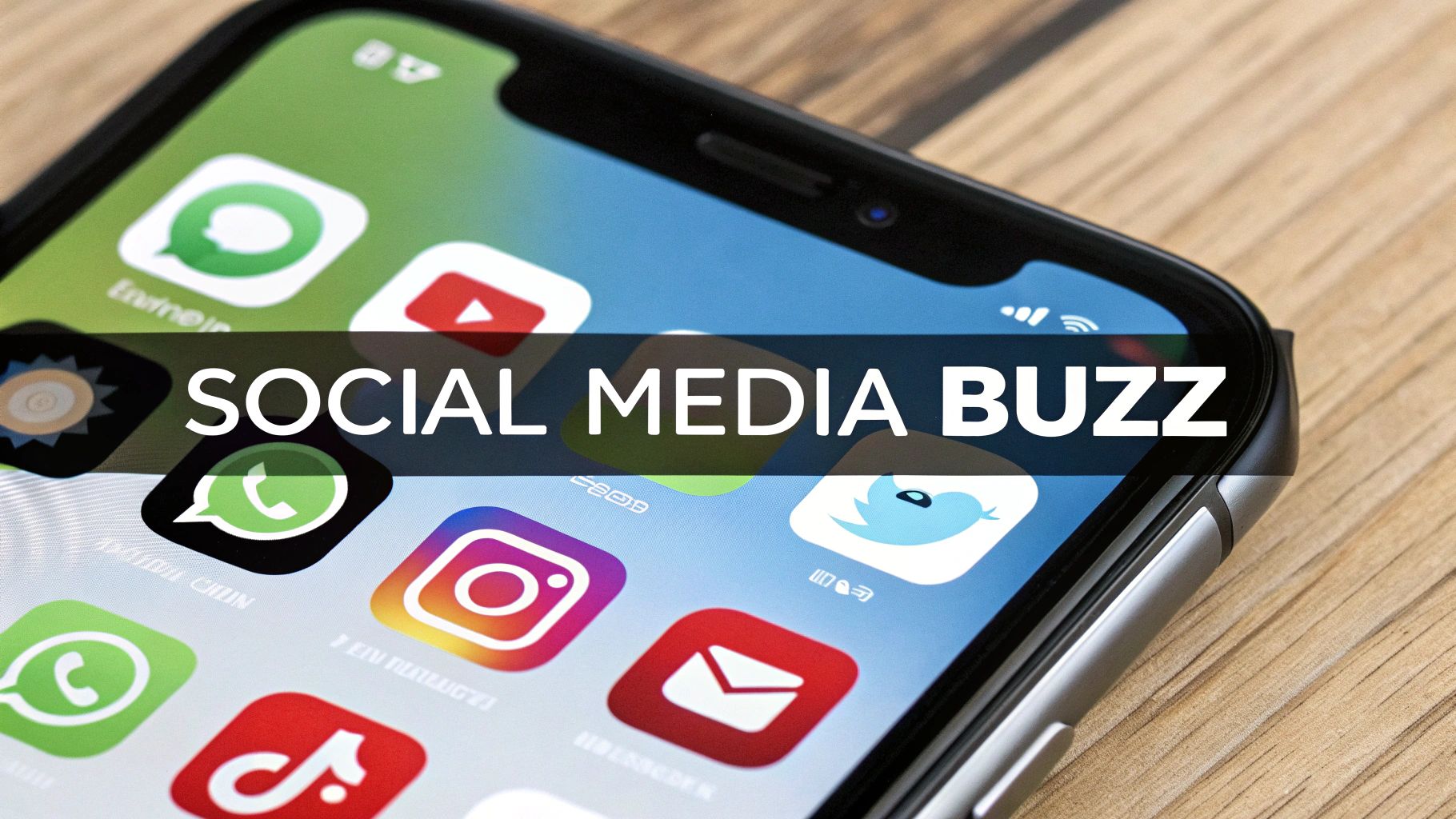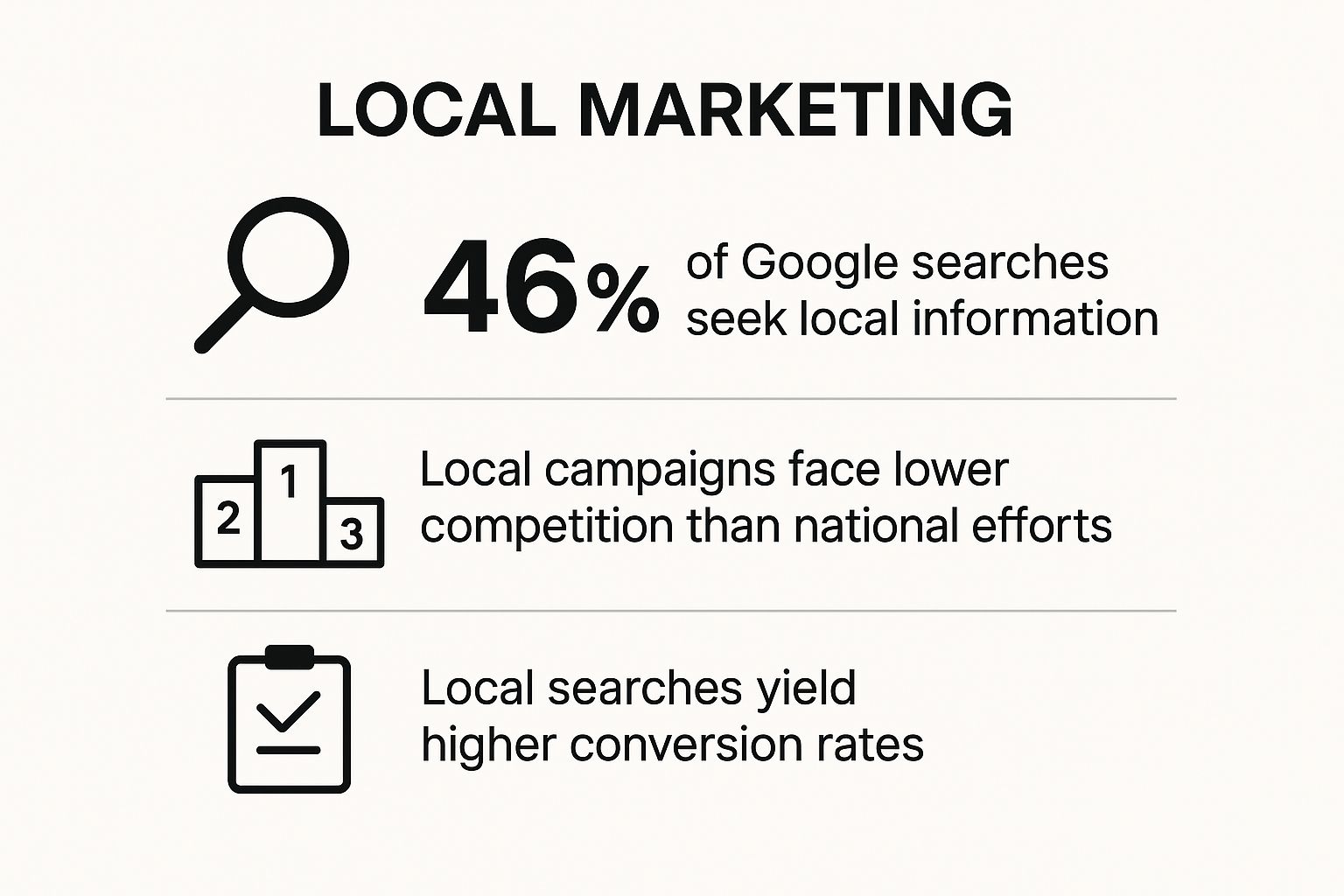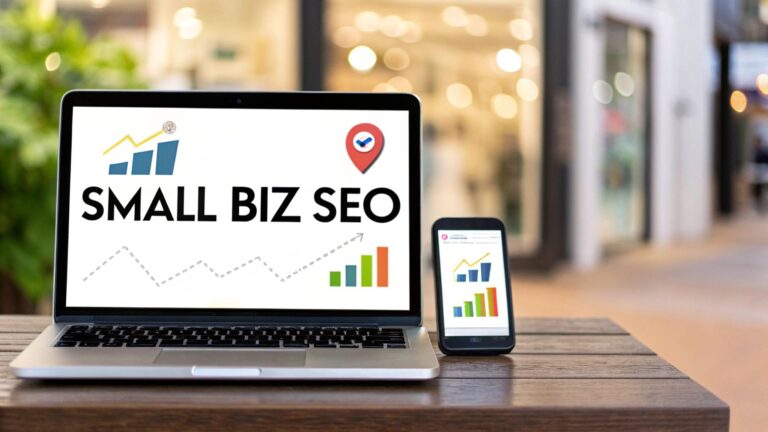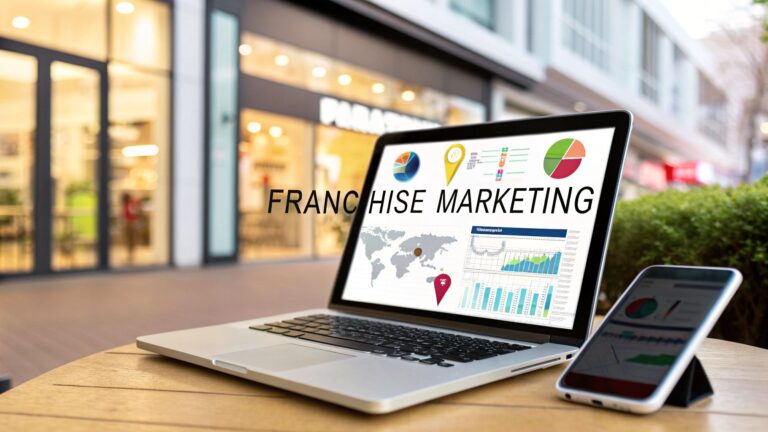For small business owners, marketing can often feel like a puzzle with too many pieces. With a finite budget and even less time, choosing where to invest your energy is critical. You don't have the luxury of trying everything; you need strategies that deliver real, measurable results without breaking the bank. This guide is built to solve that exact problem. We’ve cut through the clutter to bring you a definitive roundup of the best marketing strategies for small business growth, focusing on actionable steps you can implement immediately.
This isn't a collection of vague theories or obvious tips. Instead, we provide a practical playbook for each of the 10 core strategies, from mastering local SEO to building a referral engine that works for you. You'll find specific examples, implementation details, and fresh perspectives designed to give you a competitive edge. We will explore how a local bakery can use targeted social media ads to promote a new special or how a B2B service provider can leverage content marketing to become a recognized authority in its niche.
Our goal is to arm you with a clear, straightforward plan to attract more customers, build a loyal following, and achieve sustainable growth. These strategies are not just about getting your name out there; they are about making a tangible impact on your bottom line. While this article focuses on specific tactics, a deeper dive into crafting a holistic plan can be invaluable. For a more in-depth exploration of overall marketing approaches, consider reading this comprehensive guide to small business marketing strategy. Let’s get started on the tactics that will drive your business forward.
1. Social Media Marketing
Social media marketing is a powerful strategy that leverages platforms like Instagram, Facebook, LinkedIn, and TikTok to connect directly with your target audience. It goes beyond simply posting updates; it's about building a community, fostering brand loyalty, and driving tangible results like website traffic and sales. This approach allows small businesses to compete with larger corporations by creating authentic connections and delivering value through engaging content.

This method stands out as one of the best marketing strategies for small business because of its low barrier to entry and high potential for ROI. You can start with a small budget or even organically, focusing on creating high-quality content that resonates with your specific niche.
How to Implement Social Media Marketing
To truly harness the power of social media, small businesses need a clear plan. For a comprehensive guide, explore how to build an effective social media strategy for small businesses. A solid starting point includes:
- Platform Selection: Don't try to be everywhere. If you sell visually appealing products like handcrafted jewelry, focus on Instagram and Pinterest. If you're a B2B consultant, LinkedIn is your best bet. Practical Insight: A local coffee shop might find that a vibrant Instagram account showing daily specials and behind-the-scenes content builds a stronger community than a formal LinkedIn page.
- Content Creation: Develop a content calendar that balances promotional posts with valuable, educational, or entertaining content. Use high-quality visuals, engaging video, and compelling captions. Practical Example: A local hardware store could create short "how-to" videos on TikTok demonstrating simple home repairs, positioning themselves as a helpful resource and driving in-store traffic for supplies.
- Community Engagement: Social media is a two-way street. Respond to comments and messages promptly, ask questions, and encourage user-generated content by creating a branded hashtag. Practical Example: A pet grooming business could run a "Cutest Pet of the Month" contest using a hashtag like
#PawsomeGrooming, encouraging clients to share photos and creating a gallery of happy customers.
Why This Strategy Works
Success stories prove the model's effectiveness. The beauty brand Glossier built its empire almost entirely on Instagram, leveraging user-generated content and creating a cult-like following. Similarly, Dollar Shave Club’s viral video on YouTube and Facebook disrupted an entire industry. These examples show that creative, audience-focused content can generate massive brand awareness and drive sales without a blockbuster budget. By focusing on authentic engagement and providing value, small businesses can cultivate a loyal customer base that champions their brand.
2. Content Marketing
Content marketing is a strategic approach focused on creating and distributing valuable, relevant, and consistent content to attract and retain a clearly defined audience. Instead of directly pitching your products or services, you provide genuinely useful information that solves your audience's problems, ultimately driving profitable customer action. This builds trust, establishes authority, and nurtures leads over time.
This method is one of the best marketing strategies for small business because it creates a long-term, sustainable asset. While a paid ad stops working the moment you stop paying, a high-quality blog post or guide can attract organic traffic and generate leads for years, delivering an exceptional return on investment.
How to Implement Content Marketing
A successful content marketing plan requires more than just occasional blog posts. For a deeper dive, discover the essentials of content marketing for small business. A great starting point includes:
- Focus on Problems: Use keyword research and customer feedback to identify your audience's biggest pain points. Create content that directly answers their questions, following the "They Ask, You Answer" methodology. Practical Example: A financial advisor for freelancers could write a blog series on "How to Manage Irregular Income" or "Quarterly Tax Tips for the Self-Employed."
- Develop a Calendar: Consistency is key. Plan your content topics in advance with a content calendar to ensure a steady stream of valuable information for your audience. Practical Insight: Use a simple spreadsheet to map out your content for the next month, assigning a topic, format (blog, video, etc.), and publication date for each week.
- Repurpose Your Content: Maximize your efforts by turning one core piece of content into multiple formats. A detailed blog post can become a video, an infographic, a series of social media posts, and a podcast episode. Practical Example: A 1,500-word guide to "Choosing the Right Running Shoes" can be repurposed into a 60-second Instagram Reel summarizing the key tips and a downloadable PDF checklist for in-store use.
Why This Strategy Works
This strategy works by positioning your business as a trusted expert rather than just a seller. HubSpot, for example, built its entire marketing empire by providing an extensive blog and free resources that help businesses with their marketing challenges, generating millions of qualified leads. Similarly, Patagonia reinforces its brand values and connects with its audience through content focused on environmental activism, which resonates far more deeply than a simple product ad. By educating and empowering your audience, you build a loyal following that naturally wants to do business with you.
3. Email Marketing
Email marketing is a direct and highly effective channel for communicating with prospects and customers. It involves building a list of subscribers and sending them targeted messages, from newsletters and promotional offers to personalized updates. This strategy excels at nurturing relationships, building brand trust, and guiding potential customers through the sales funnel, ultimately driving conversions and repeat business.
This method is one of the best marketing strategies for small business because it offers one of the highest returns on investment. Unlike social media, you own your email list, giving you a direct line to your audience that isn't controlled by an algorithm. This ownership and control make it a stable and predictable revenue driver.
How to Implement Email Marketing
A successful email marketing campaign is built on trust and value. It's not about spamming inboxes; it's about delivering the right message to the right person at the right time. Key steps include:
- Build Your List Organically: Offer a valuable incentive, or "lead magnet," like a free ebook, a discount code, or an exclusive guide in exchange for an email address. Place sign-up forms prominently on your website and social media profiles. Practical Example: A bookstore could offer a "Top 10 Must-Reads of the Season" PDF guide to anyone who signs up for their newsletter.
- Segment Your Audience: Don't send the same email to everyone. Group your subscribers based on their interests, purchase history, or engagement level. This allows you to send highly relevant content that resonates and converts. Practical Insight: An online clothing store can create segments for "New Customers," "VIPs" (frequent buyers), and "Customers who bought sweaters," sending each group tailored offers and content.
- Craft Compelling Emails: Focus on writing irresistible subject lines to boost open rates. Ensure your email design is clean, mobile-friendly, and includes a clear call-to-action (CTA) that tells the reader exactly what to do next. Practical Example: Instead of "July Newsletter," use a subject line like "🔥 Heads Up: Our Summer Sale Ends in 48 Hours!" to create urgency.
Why This Strategy Works
Email marketing consistently delivers results by creating a personalized connection. For example, Airbnb sends tailored travel recommendations based on a user's browsing history, making the content incredibly relevant. On a smaller scale, e-commerce stores routinely recover 10-15% of lost sales simply by implementing automated abandoned cart emails. Another powerful example is TheSkimm, which built a massive media company primarily through its daily email newsletter. These cases prove that by providing consistent value directly to the inbox, small businesses can cultivate a loyal audience that is eager to buy.
4. Search Engine Optimization (SEO)
Search Engine Optimization (SEO) is the practice of optimizing your website and content to rank higher in search engine results pages (SERPs) for relevant keywords. It is a fundamental digital marketing discipline focused on increasing organic, or non-paid, website traffic from search engines like Google and Bing. By strategically improving your online presence, you make it easier for potential customers to find you when they are actively searching for your products or services.

This method is one of the best marketing strategies for small business because it generates highly qualified traffic and builds long-term brand authority. Unlike paid ads, which stop working the moment you stop paying, a strong SEO foundation can deliver consistent results for months or even years, offering an exceptional return on investment over time.
How to Implement SEO
Effective SEO requires a multi-faceted approach that combines technical know-how with high-quality content creation. For an in-depth understanding of modern SEO, consider exploring essential strategies for AI search engine optimization. Key steps to get started include:
- Keyword Research: Identify the terms your target audience uses to find businesses like yours. Focus on long-tail keywords (e.g., "handmade leather wallets for men") which are more specific and often have less competition. Practical Insight: Use a free tool like Google Keyword Planner to find terms with high purchase intent, such as "emergency roof repair" instead of just "roofer."
- On-Page SEO: Optimize individual web pages by including your target keywords in titles, meta descriptions, headers, and content. Ensure your content is comprehensive, valuable, and answers the searcher's query completely. Practical Example: A page about dog training services should have a title like "Puppy Training Classes in [Your City] | [Your Business Name]" to capture local search intent.
- Technical SEO: Make sure your website is mobile-friendly, loads quickly, and has a clear structure that is easy for search engines to crawl. Practical Insight: Use Google's PageSpeed Insights tool to get a free report on your site's performance and actionable tips for improvement.
- Local SEO: If you have a physical location, claim and optimize your Google Business Profile. This helps you appear in "near me" searches and on Google Maps, driving local foot traffic. Practical Example: Ensure your profile includes up-to-date hours, photos of your storefront, a list of services, and your business phone number.
Why This Strategy Works
SEO is powerful because it connects your business with customers at the exact moment they have a need. For example, e-commerce giant Zappos built its empire by dominating search results for thousands of shoe-related keywords. On a smaller scale, a local bakery that optimizes for "best birthday cakes in [City Name]" can attract nearby customers ready to make a purchase. These examples demonstrate that by aligning your content with user intent, you can capture high-value traffic and establish your business as a trusted authority in your niche without a massive advertising budget.
5. Local Marketing
Local marketing focuses on attracting customers within a specific geographic area, such as a neighborhood or city. This strategy is essential for brick-and-mortar businesses and service providers, as it connects you directly with the community you serve. It involves a mix of online tactics like local SEO and offline efforts like community involvement, building a strong, credible presence right in your backyard.
This infographic highlights key statistics that underscore the power of focusing on a local audience.

These numbers confirm that a significant portion of online searches have local intent, offering small businesses a less competitive and higher-converting arena to win customers. This makes it one of the best marketing strategies for small business owners looking to maximize their impact with a limited budget.
How to Implement Local Marketing
A successful local marketing strategy requires a multi-pronged approach that builds both digital and physical visibility. You can start by:
- Claiming Your Digital Territory: Your first step is to claim and fully optimize your Google Business Profile. This is a free tool that acts as your business's digital storefront on Google Search and Maps. Practical Insight: Regularly use the Google Posts feature to announce events, special offers, or new products directly on your profile to keep it fresh and engaging.
- Encouraging Reviews: Actively ask satisfied customers to leave reviews on platforms like Google, Yelp, and industry-specific sites. Positive reviews build social proof and significantly boost your local search ranking. Practical Example: A restaurant can print a QR code on its receipts that links directly to its Google review page, making it easy for happy diners to leave feedback.
- Community Engagement: Get involved offline. Sponsor a local youth sports team, set up a booth at a community festival, or host a workshop. These actions build goodwill and brand recognition within the community. Practical Example: A yoga studio could offer a free "Yoga in the Park" session on a Saturday morning to introduce themselves to the community and sign up new members.
- Local Partnerships: Collaborate with non-competing local businesses for cross-promotions. For example, a home painter could partner with a local real estate agent to gain referrals. Practical Insight: A local boutique could partner with a nearby café to offer a "Shop & Sip" event, where customers get a discount at both locations on a specific day.
Why This Strategy Works
Local marketing works because it builds on trust and proximity. When customers search for "coffee shop near me," they are ready to make a purchase. By optimizing for these searches, you capture high-intent customers at the exact moment they need you. For example, a local plumbing company that dominates "near me" searches and has dozens of positive reviews will almost always win the business over a larger, non-local competitor.
Similarly, a restaurant partnering with local food delivery apps can target specific neighborhoods with special offers, driving immediate foot traffic. These targeted, community-focused efforts create a loyal customer base that feels a genuine connection to your brand, ensuring sustained growth and a strong local reputation.
6. Referral Marketing
Referral marketing transforms your happiest customers into a powerful sales force by incentivizing them to recommend your business to their network. This word-of-mouth strategy capitalizes on trust, as a recommendation from a friend is far more persuasive than a traditional advertisement. It's about systematically encouraging and rewarding existing customers for bringing in new ones, creating a self-sustaining cycle of growth.
This method is one of the best marketing strategies for a small business because it is incredibly cost-effective and generates high-quality leads. Referred customers often have a higher lifetime value and are more loyal, as they come in with pre-established trust in your brand. It’s a direct way to leverage your existing customer base for acquisition.
How to Implement Referral Marketing
A successful referral program is simple, rewarding, and easy to share. It requires a clear structure that motivates both the referrer and the new customer. For deeper insights, you can explore the principles popularized by growth experts like Andrew Chen. A great starting point includes:
- Offer Compelling Incentives: The reward must be valuable enough to motivate action. Consider offering a two-sided incentive, where both the referrer and the new customer receive a benefit, like a discount, store credit, or a free product. Practical Example: A lawn care service could offer the referrer a $50 credit and the new customer $50 off their first service. This "give $50, get $50" model is highly effective.
- Make Sharing Effortless: Provide customers with a unique, easy-to-share referral link or code. Integrate sharing options for email, social media, and messaging apps directly into your website or customer portal to make the process seamless. Practical Insight: Use a simple referral marketing tool like ReferralCandy or GrowSurf to automate the generation of links and the tracking of rewards.
- Timing is Everything: Ask for a referral at the peak of customer satisfaction. This could be right after a positive review is left, a repeat purchase is made, or a customer service issue is successfully resolved. Practical Example: An accounting firm could send an automated email asking for a referral one week after successfully filing a client's annual tax return.
Why This Strategy Works
Success stories highlight the immense power of a well-executed referral program. Dropbox famously grew its user base by 3900% in 15 months by offering free storage space to both the referrer and the new user. Similarly, Uber’s early growth was heavily fueled by its rider and driver referral bonuses, which incentivized rapid, widespread adoption. These examples demonstrate that by providing a clear and valuable incentive, small businesses can create an organic growth engine driven by their most loyal advocates, significantly lowering customer acquisition costs and building a stronger community around their brand.
7. Networking and Partnerships
Networking and partnerships involve building mutually beneficial relationships with other businesses, industry professionals, and organizations to expand your reach and create collaborative opportunities. Instead of viewing others in your space as competitors, this strategy focuses on creating synergistic connections that provide long-term value to all parties involved, leveraging combined strengths to achieve shared goals.
This approach is one of the best marketing strategies for small business because it allows you to tap into new audiences with built-in trust and credibility. By aligning with a respected partner, you gain an implied endorsement that can be more powerful than traditional advertising, often at a fraction of the cost.
How to Implement Networking and Partnerships
Effective partnerships are built on a foundation of mutual value and clear communication. A solid plan will help you identify and nurture the right relationships. To get started, consider the following steps:
- Identify Potential Partners: Look for non-competing businesses that serve a similar customer demographic. A local gym, for instance, could partner with a nutritionist, while an e-commerce brand selling hiking gear could collaborate with a travel blogger. Practical Example: A wedding photographer can partner with a local florist, venue, and caterer to create a "preferred vendor" list that they all share with their clients, generating warm leads for everyone.
- Provide Value First: As author Keith Ferrazzi suggests in Never Eat Alone, focus on what you can offer before asking for anything in return. Be generous with referrals, share their content, and actively look for ways to support your potential partners to build goodwill. Practical Insight: If you're a web designer, offer a free website audit to a marketing agency you'd like to partner with, demonstrating your expertise and value upfront.
- Formalize Agreements: Once you've established a connection, document the partnership terms clearly. Outline the responsibilities, goals, and duration of the collaboration to prevent misunderstandings and ensure both parties are aligned. Practical Insight: Even a simple one-page document outlining the commission structure for referrals or the promotional responsibilities for a joint webinar can save a lot of headaches later.
Why This Strategy Works
Success stories highlight the power of collaboration. The partnership between Spotify and Uber allowed riders to control the music during their trip, enhancing the customer experience for both brands and cross-promoting their services seamlessly. On a smaller scale, a local wedding photographer who partners with a florist can create referral packages that benefit both businesses and provide a convenient, trusted solution for clients. These examples show that strategic alliances create a win-win scenario, driving customer acquisition and enhancing brand reputation through shared value and a unified customer experience.
8. Pay-Per-Click (PPC) Advertising
Pay-Per-Click (PPC) advertising is a powerful digital marketing model where businesses pay a fee each time one of their ads is clicked. This strategy allows you to place targeted ads on search engines like Google, social media platforms like Facebook, and other websites, effectively buying visits to your site rather than trying to earn them organically. It provides immediate visibility and highly measurable results.
This method is one of the best marketing strategies for small business because it offers immense control and speed. You can launch a campaign and start seeing traffic within hours, making it ideal for businesses that need to generate leads or sales quickly. The ability to target specific demographics, keywords, and interests ensures your ad spend is directed toward the most relevant audience.
How to Implement Pay-Per-Click Advertising
A successful PPC campaign requires strategic planning and ongoing optimization. For local service businesses, it's particularly effective. Explore an in-depth guide on using Google Ads for local businesses to capture a nearby customer base. A solid foundation includes:
- Keyword Research: Identify the search terms your potential customers are using. Focus on long-tail keywords (e.g., "emergency plumber in brooklyn") as they often have lower competition and higher conversion rates. Practical Insight: Use "negative keywords" to prevent your ads from showing for irrelevant searches. A company selling high-end furniture should add "-free" and "-cheap" as negative keywords to avoid wasting money on bargain hunters.
- Compelling Ad Copy: Write clear, concise ads that highlight your unique value proposition and include a strong call-to-action (CTA) like "Get a Free Quote Today" or "Shop Now & Save 20%." Practical Example: An ad for a cleaning service could use the headline "Book Your Spotless Home in 60 Seconds" to emphasize speed and convenience.
- Optimized Landing Pages: Ensure the page users land on after clicking your ad is directly relevant to their search. A dedicated landing page with a clear offer and simple navigation drastically improves conversion rates. Practical Insight: If your ad promotes a "20% Off" sale on shoes, the landing page should feature shoes with the discount already applied, not just your homepage.
- Budget Management: Start with a modest daily budget to test your campaigns. As you identify which ads and keywords are performing well, you can strategically reallocate your funds to scale up. Practical Insight: Set a daily budget of $10-$20 to start. Run the campaign for a week to gather data, then analyze which keywords are driving clicks and conversions before increasing the budget.
Why This Strategy Works
PPC delivers immediate and quantifiable results, making it easy to track your return on investment. For example, a local bakery can use Google Ads to target users searching for "custom birthday cakes near me," instantly connecting with customers at the exact moment they intend to buy. Similarly, an e-commerce store can use Facebook Ads to retarget users who abandoned their shopping carts, reminding them of the products they viewed and encouraging them to complete the purchase.
This direct-response nature is what makes PPC so effective. Unlike long-term strategies like SEO, you can quickly test offers, messaging, and target audiences to find what works best. This agility allows small businesses to compete effectively and drive predictable growth by paying only for a direct expression of interest in their products or services.
9. Customer Retention Marketing
Customer retention marketing is the strategic practice of keeping your existing customers engaged, happy, and loyal to your brand. Instead of solely focusing on acquiring new leads, this approach prioritizes nurturing the relationships you've already built. It's founded on the proven principle that it is significantly more cost-effective to retain a customer than to acquire a new one, maximizing profitability by increasing customer lifetime value.
This powerful approach is one of the best marketing strategies for small business because it turns satisfied buyers into repeat customers and, eventually, brand advocates. Loyal customers tend to spend more over time and provide valuable word-of-mouth marketing, creating a sustainable cycle of growth that is less dependent on expensive acquisition campaigns.
How to Implement Customer Retention Marketing
A successful retention strategy requires a proactive, customer-centric mindset. It’s about consistently delivering value long after the initial purchase. Key steps to get started include:
- Implement a Loyalty Program: Reward repeat business with points, discounts, or exclusive access. This incentivizes customers to choose you over competitors. Practical Example: A local cafe can offer a simple punch card: "Buy 9 coffees, get the 10th free." This classic method is effective and easy to manage.
- Personalize Communications: Use purchase history and customer data to send targeted emails with relevant product recommendations, special offers, and content that speaks directly to their needs. Practical Example: A pet store can send a reminder email a month after a customer buys a bag of dog food, suggesting it might be time to reorder and including a small discount.
- Seek and Act on Feedback: Regularly send out surveys or request reviews to understand the customer experience. Crucially, demonstrate that you are listening by acting on the feedback you receive. Practical Insight: If multiple customers mention that your checkout process is confusing, make it a priority to fix it and then email those customers to thank them for their feedback and inform them of the update.
- Provide Exceptional Support: Make it easy for customers to get help. Fast, friendly, and effective customer service can turn a negative experience into a reason for a customer to stay loyal. Practical Example: Use a simple live chat tool on your website to answer questions in real-time, preventing potential customers from leaving your site in frustration.
Why This Strategy Works
Success stories highlight the immense value of customer loyalty. The Starbucks Rewards app is a prime example, using a gamified system of points ("Stars") to encourage frequent visits and higher spending. Similarly, Amazon Prime's membership model locks customers into its ecosystem by offering immense value through free shipping, streaming, and other perks, making it the default choice for online shopping. These businesses prove that investing in the post-purchase experience creates a loyal base that provides predictable revenue and acts as a powerful engine for organic growth.
10. Influencer Marketing
Influencer marketing is a strategy that involves collaborating with individuals who have a dedicated social following or authority in a specific niche to promote your products or services. This approach leverages the trust and credibility influencers have built with their audience, turning a recommendation into a powerful endorsement. It allows small businesses to tap into highly engaged, pre-existing communities to boost brand awareness and drive sales.

This method is one of the best marketing strategies for small business because it offers an authentic, human-centric way to reach potential customers. Rather than a direct advertisement, an influencer's post acts as a trusted peer review, which can be far more persuasive and generate a higher return on investment, especially when using cost-effective micro-influencers.
How to Implement Influencer Marketing
A successful influencer campaign requires careful planning and genuine partnership. Your approach should feel authentic to both your brand and the influencer's audience. To manage perceptions effectively, you might explore insights on small business online reputation management. A great starting point includes:
- Find the Right Influencers: Focus on relevance over reach. A micro-influencer (10k-100k followers) with a highly engaged, niche audience that matches your target customer is often more valuable than a macro-influencer with millions of generic followers. Practical Example: A brand selling sustainable yoga mats should partner with a local yoga instructor with 5,000 engaged followers rather than a general fitness celebrity with 1 million followers who have no specific interest in yoga.
- Set Clear Goals and Guidelines: Define what you want to achieve, whether it's brand awareness, lead generation, or sales. Provide clear creative guidelines but allow the influencer freedom to create content in their own voice to maintain authenticity. Practical Insight: Instead of sending a rigid script, provide key talking points and let the influencer weave them into their natural content style. For example: "Please mention that our product is vegan and cruelty-free."
- Track Your Results: Use unique discount codes, affiliate links, or dedicated landing pages to measure the ROI of your campaign. This data will help you understand what works and refine future collaborations. Practical Example: Give each influencer a unique code like "SARA15" for 15% off. This allows you to track exactly how many sales each partnership generates.
Why This Strategy Works
This strategy's power lies in its authenticity. The watch brand Daniel Wellington famously grew into a multi-million dollar company by partnering with thousands of Instagram influencers, turning their product into a must-have accessory. On a local level, a restaurant can achieve immediate results by collaborating with a popular food blogger for a review. These examples show that by placing your product in the hands of trusted voices, you can build credibility and drive conversions far more effectively than with traditional advertising. It’s about borrowing trust to build your own.
Top 10 Marketing Strategies Comparison
| Marketing Strategy | Implementation Complexity 🔄 | Resource Requirements ⚡ | Expected Outcomes 📊 | Ideal Use Cases 💡 | Key Advantages ⭐ |
|---|---|---|---|---|---|
| Social Media Marketing | Medium — ongoing content creation and engagement required | Moderate — content, ads, tools, and time | Increased brand awareness, audience engagement, traffic | Brands targeting multi-platform audiences, direct customer interaction | Cost-effective, real-time engagement, valuable customer insights |
| Content Marketing | Medium to High — requires strategic planning and diverse content creation | Moderate to High — writing, video, SEO skills, tools | Long-term organic traffic growth, improved authority | Businesses aiming for thought leadership and SEO growth | Builds trust, cost-effective, sustainable lead generation |
| Email Marketing | Low to Medium — setup automated campaigns and segmentation | Low to Moderate — email platforms and content | High ROI, direct conversions and customer nurturing | Businesses with existing audience lists, direct sales focus | High ROI, personalized targeting, automation saves time |
| Search Engine Optimization (SEO) | High — technical and content optimization needed | Moderate to High — SEO expertise and tools | Increased organic search rankings and qualified traffic | Businesses looking for sustained organic growth and visibility | Cost-effective, durable competitive advantage, measurable impact |
| Local Marketing | Medium — requires local engagement and listings optimization | Low to Moderate — local outreach, directory management | Targeted local traffic and higher conversion rates | Local businesses focusing on geographic proximity | High conversion, community building, cost-effective for small areas |
| Referral Marketing | Low to Medium — setup referral programs and incentives | Low to Moderate — referral platforms and rewards | Increased customer acquisition via word-of-mouth | Businesses with satisfied customers looking to grow organically | Low acquisition costs, high-quality leads, viral growth potential |
| Networking and Partnerships | Medium to High — relationship building and ongoing collaboration | Low to Moderate — time and event participation | Access to new audiences, collaborative growth | B2B and professional services seeking strategic alliances | Expands reach, builds credibility, generates referrals |
| Pay-Per-Click (PPC) Advertising | Medium — requires campaign management and optimization | Moderate to High — ad spend and management time | Immediate traffic and measurable ROI | Time-sensitive promotions, targeted advertising campaigns | Immediate visibility, precise targeting, budget control |
| Customer Retention Marketing | Medium — ongoing loyalty and personalized engagement | Moderate — CRM tools and customer support | Increased customer lifetime value and retention | Businesses focused on maintaining and growing existing customers | Cheaper than acquisition, improves loyalty, predictable revenue |
| Influencer Marketing | Medium — collaboration and content coordination | Moderate to High — influencer fees and management | Brand awareness, targeted audience reach, social proof | Brands seeking authentic promotion via trusted individuals | Access to engaged audiences, authentic content, niche targeting |
Choosing Your Path to Marketing Success
Navigating the landscape of marketing can feel like an overwhelming task, especially for a small business owner juggling multiple responsibilities. The ten comprehensive strategies detailed in this article, from the community-building power of social media to the precision of pay-per-click advertising, are not just a list of options; they are a toolkit for sustainable growth. The true challenge, and the greatest opportunity, lies not in trying to do everything at once, but in selecting the right tools for your unique business.
The most effective approach is to begin with a focused, strategic mindset. Instead of spreading your resources thin across all ten avenues, select one or two that resonate most deeply with your current business goals and target audience. Is your primary objective to drive foot traffic to a physical location? Then diving deep into Local Marketing and mastering your Google Business Profile should be your top priority. Are you a service-based business with a long sales cycle? Content Marketing combined with a sophisticated Email Marketing funnel will likely yield the best long-term results. The key is to choose a path and commit to it.
From Strategy to Action: Your Next Steps
The difference between a list of ideas and a successful marketing plan is execution. Once you've identified your starting point, the real work begins. The best marketing strategies for small business are those that are implemented consistently and measured meticulously.
Here’s a practical framework to turn insight into action:
- Audit Your Current Efforts: Before you build something new, understand what you already have. Do you have an existing email list? An unoptimized social media profile? A website with no SEO foundation? A quick audit reveals low-hanging fruit and clarifies where your initial focus should be.
- Set SMART Goals: Vague goals like "get more customers" are not helpful. Instead, set Specific, Measurable, Achievable, Relevant, and Time-bound goals. For example: "Increase website traffic from organic search by 15% in the next quarter by publishing four optimized blog posts and acquiring three high-quality backlinks."
- Create a 90-Day Plan: Break down your chosen strategy into a manageable 90-day action plan. If you chose Referral Marketing, your plan might include launching a formal program, creating shareable assets for current customers, and setting up a tracking system within the first 30 days. This transforms a big idea into a series of achievable tasks.
The Power of Integration and Adaptation
As you master your initial one or two strategies, you will discover they don’t operate in a vacuum. A powerful Content Marketing article can be promoted through Email Marketing, shared on social media, and optimized for SEO to create a synergistic effect. A successful Networking event can lead to Partnership opportunities that fuel your Referral Marketing program. This integration is where marketing momentum truly builds.
Remember, the market is not static. Customer behaviors change, new platforms emerge, and algorithms are updated. The strategies that work wonders today may need adjustment tomorrow. This is why ongoing measurement is non-negotiable. Track your key performance indicators (KPIs), whether it's your email open rate, website conversion rate, or customer acquisition cost. Use this data not to judge success or failure, but to learn, adapt, and refine your approach. This iterative process of executing, measuring, and optimizing is the engine of all successful small business marketing. Ultimately, your commitment to this cycle will determine your long-term success more than any single strategy you choose.
Feeling overwhelmed by the technical details of SEO or the complexities of managing paid ad campaigns? If you're ready to implement the best marketing strategies for a small business but need an expert partner to accelerate your growth, the team at Latitude Park can help. We specialize in executing targeted Google Ads, Meta ads, and comprehensive SEO campaigns that drive measurable results for franchises and small businesses. Visit Latitude Park to learn how we can build a customized marketing engine for your brand.









